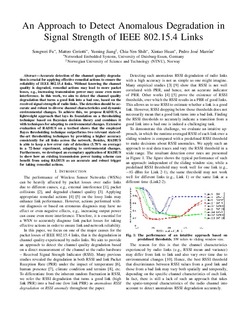An Approach to Detect Anomalous Degradation in Signal Strength of IEEE 802.15.4 Links
Chapter
Accepted version

Åpne
Permanent lenke
http://hdl.handle.net/11250/2593551Utgivelsesdato
2018Metadata
Vis full innførselSamlinger
Originalversjon
10.1109/SAHCN.2018.8397126Sammendrag
Accurate detection of the channel quality degradation is crucial for applying effective remedial actions to ensure the reliability of IEEE 802.15.4 links. Without knowing the channel quality is degraded, remedial actions may lead to more packet losses, e.g., increasing transmission power may cause even more interference. In this work, we aim to detect the channel quality degradation that turns a good link into a bad one, based on the received signal strength of radio links. The detection should be accurate and robust to diverse channel characteristics and dynamic environmental changes. To achieve this, we propose RADIUS, a lightweight approach that lays its foundation on a thresholding technique based on Bayesian decision theory and combines it with techniques for adapting to environmental changes. Extensive evaluation of RADIUS on a testbed shows that the employed Bayes thresholding technique outperforms two relevant state-of-the-art thresholding techniques by providing a higher accuracy consistently for all links across the network. Besides, RADIUS is able to keep a low error rate of detection (5.78% on average) in a 72-hour experiment, adapting to environmental changes. Furthermore, we developed an exemplary application of RADIUS to show how an existing transmission power tuning scheme can benefit from using RADIUS as an accurate and robust trigger for taking remedial actions.